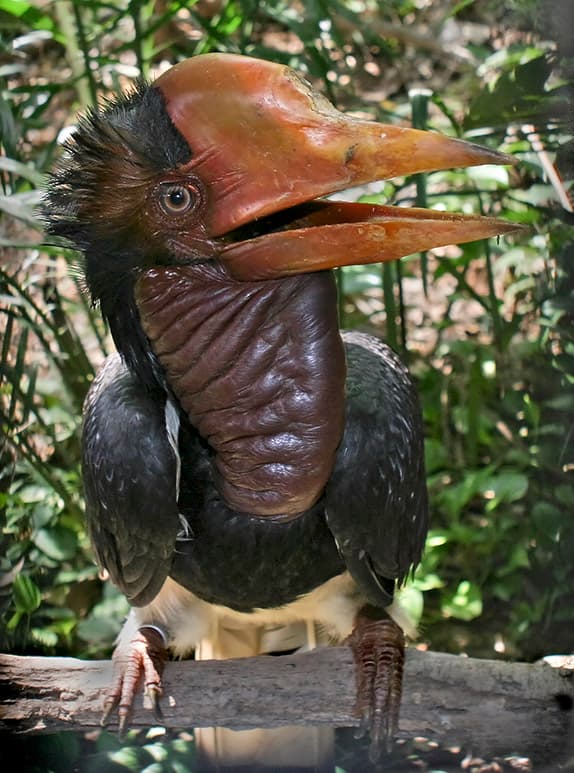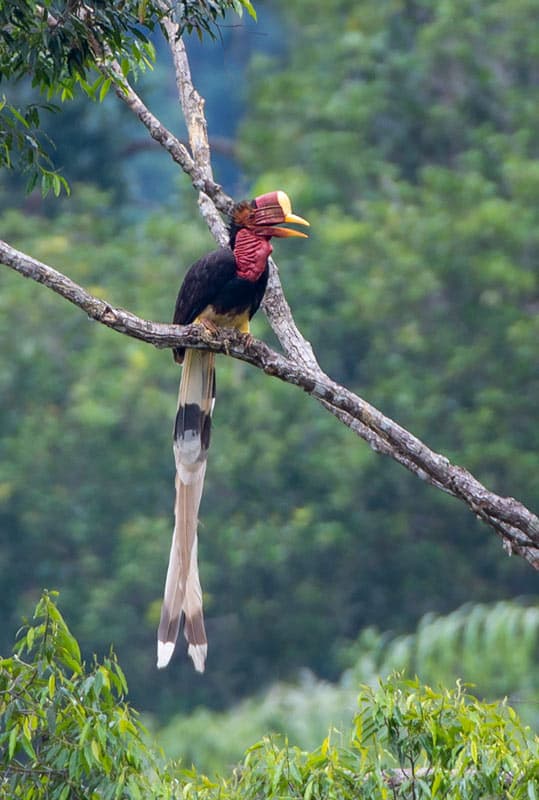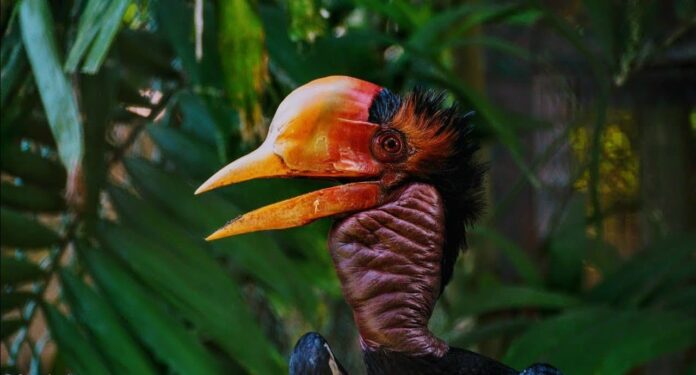Hornbills are spectacular birds, and the helmeted hornbill is on another level when it comes to appearance. Among the 62 hornbill species, this one is rather one of the very unique few that you don’t come across much. Being the largest hornbill in the family is not the only thing that this bird possesses, there are so many more. Want to find out? Check out all the information about them below.
1Appearance

A helmeted hornbill is around 110 to 120 centimeters long, excluding its 50 centimeters tail feather. It has a blackish plumage with a white belly, legs, and tail. Its long tail has a black band near the tip of the feather, and the two central tail feathers are longer than others. If you look at the throat, you will notice the bare wrinkled throat patch that looks quite peculiar. The throat patch is pale blue to greenish in females and it is red in males.
The helmeted hornbills are notable for their distinctive casque, the helmet-like structure on the bird’s head. This casque is a solid block of ivory-like substance which is different from other hornbills’ hollow casque. The casque, bill, and skull account for around 11% of its weight, and the bird weighs only 3 kilograms. Is it just for show? No. Helmeted hornbills use this casque in head-to-head combat among males to protect territory, the fight is called “aerial jousting”. Aerial jousting is very common but jousting to death is very rare.
2Behavior

Helmeted hornbills are monogamous and territorial so it is not common to see them in groups. The pair breeds once a year, and the female only lays one egg and she looks after the chick. Both the mother and chick live inside a sealed tree cavity for the first 6 months of the chick’s life. The couple seals the opening of the tree with feces, food remains, and mud, leaving a small hole. That way, the male can pass regurgitated food to the female when she incubates the egg and takes care of the chick.
This hornbill species is famous for its unique arresting call that ends in a show-stopping flurry of hysterical laughter. Some people may have heard the calls but never see which animal makes that call. Those who have heard them described the laugh of a helmeted hornbill as maniacal which can be heard from 2 kilometers away.
3Feeding & Habitats

A majority of a helmeted hornbill’s diet consists of strangler figs, and aerial jousting is also common around fig trees. These birds sometimes fight over access to figs in areas where food sources are not abundant. There are also reports that they also actively hunt animal prey such as nestlings, reptiles, rodents, and more. The combination of agile speed and strong bill allows them to successfully hunt in large forest trees. However, small animal prey only makes up around 2% of their diet.
These exotic birds are native to Southeast Asian countries including Brunei Darussalam, Cambodia, Indonesia, Malaysia, Myanmar, and Thailand. The common habitats are usually dense tropical forests with tall large trees in lowland to sub-montane forests. Also, this hornbill species lives in forests, with a large population in primary Sundaic rainforests and adjacent closed secondary forests. They are also quite common in pristine lowland tropical rainforests where fruiting trees are plenty. Helmeted hornbills are classified as Critically Endangered on the IUCN Red List due to habitat loss and hunting pressure. Other threats are forest fires, illegal logging, and reduced suitable habitats for breeding.
Related Post: Fascinating Birds With Large Bills




